On the day when I published on my blog a text on the visit to Italy in the spring of 2018 in which I mentioned an encounter with my friend Rade I actually went on a proper visit to that same Rade. Namely, he currently works in Copenhagen, has a guest room there and has invited me to visit him and Denmark. I thought there was not much for me to ponder on the topic, but rather in coordination with him about the dates I just bought a plane ticket.
Admittedly, the plane ticket was to Malmo, Sweden, but with the construction of a bridge between Sweden and Denmark, there is a coach from the Malmo airport to Copenhagen and it takes around one hour.
Because of the delay of the flight departing from Belgrade, everything was significantly late, but I still managed to get to my friend's before midnight and then we had to chat a little, so I went to bed around 1 am.
That meant that the following morning I woke up feeling almost as if I had a hangover, so I enjoyed very much the slow walking up and idling. A little later Rade and I went to buy some groceries and then we also had late breakfast. It was only after a couple of hours of chatting that we went for a walk around the city.
Although before coming to Denmark I did look into what was interesting to see around the country, I must admit that I did not go into too many details, but I eventually visited the places marked on the map.
The main reason why I did not want to make a detailed plan in advance was that I wanted to see with my friend if he was interested in visiting something together with me, since this was his weekend off work after all, so I left everything open. Thus, on this first day, we went for a totally casual walk around Copenhagen and I enjoyed it a great deal. Rade lives in Frederiksberg, a fully autonomous municipality that is completely surrounded by Copenhagen with which it makes a whole in every practical sense of meaning, but the local inhabitants do insist on their independence. In order for me to get to know the surroundings better, we headed on foot towards the centre of the city and that was a very pleasant walk.
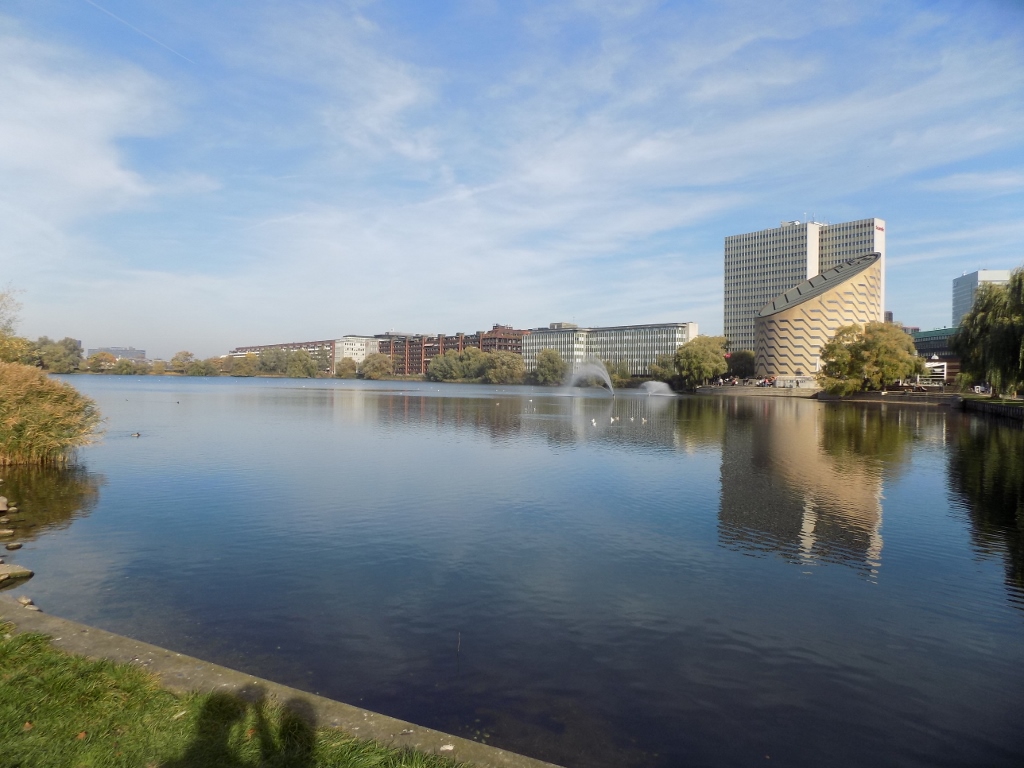 Sankt Jørgens Sø, one of the lakes in Copenhagen
Sankt Jørgens Sø, one of the lakes in Copenhagen
As it can be seen in the photo, the weather was fantastic, not only that it was sunny, but we also had a very pleasant temperature. It really suited me to start slowly getting to learn about the distribution of different places within the city, by adding images to the roughly memorised map in my head, thus facilitating my future orientation for me.
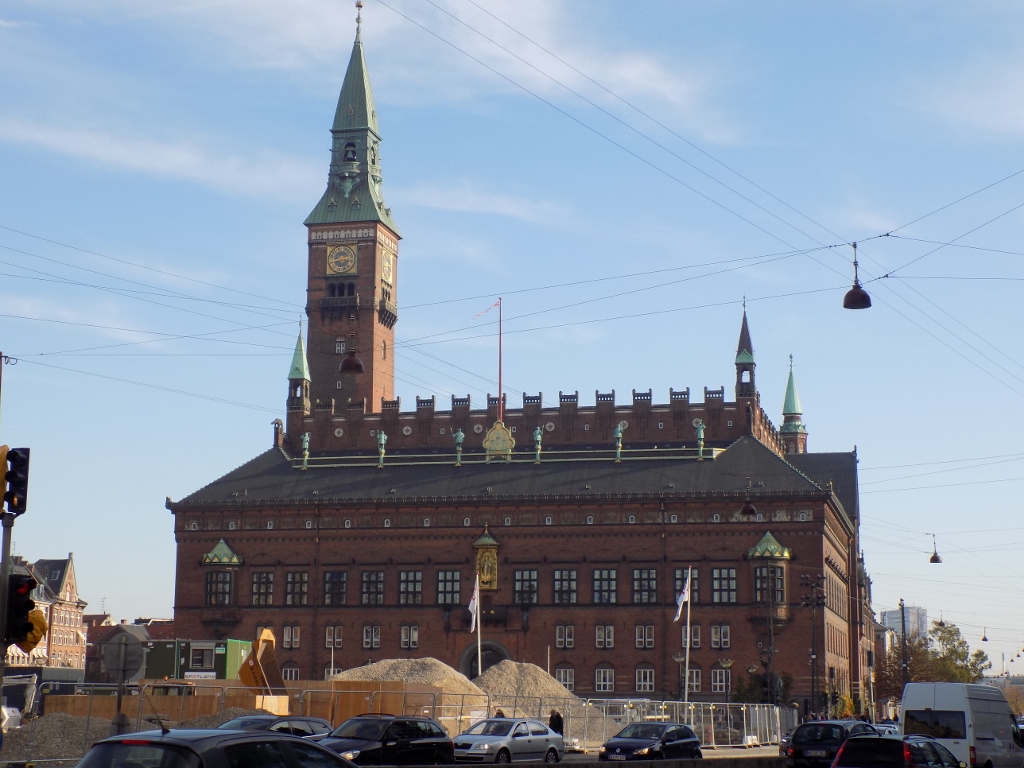 The City Hall in Copenhagen
The City Hall in Copenhagen
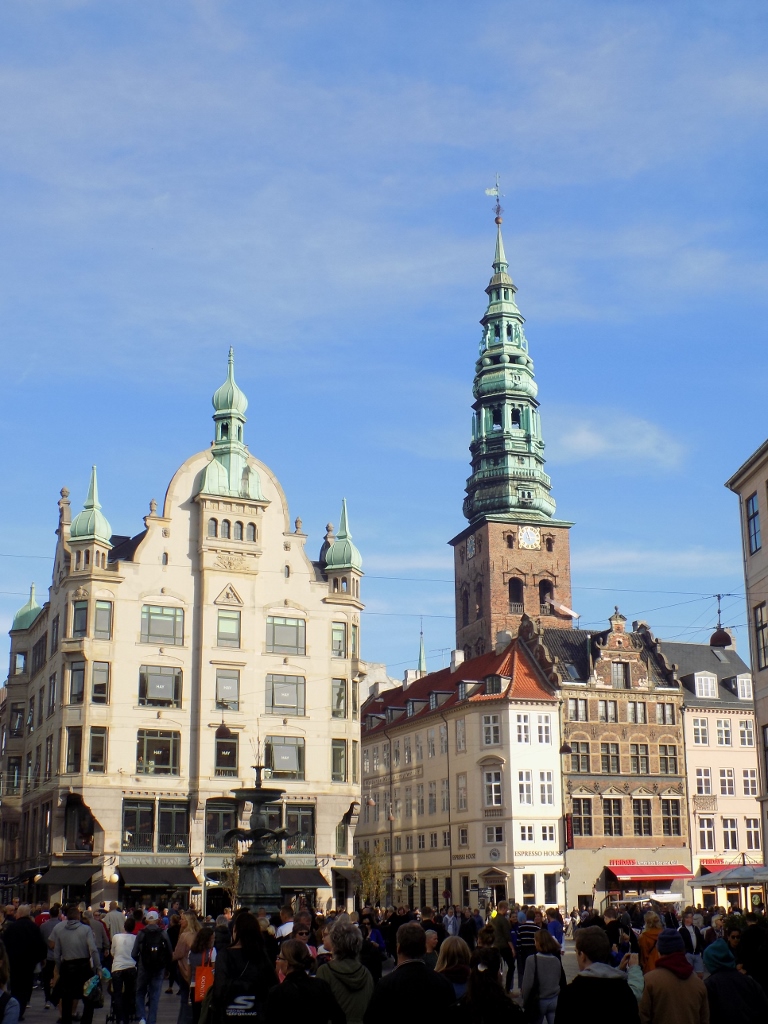 A view from the walking street – the Stork Fountain and the tower of the former Church of St Nicholas, today a modern artistic centre
A view from the walking street – the Stork Fountain and the tower of the former Church of St Nicholas, today a modern artistic centre
The main walking street of Copenhagen, Strøget, is one of the longest walking streets in Europe and, of course, it is full of shops. Rade and I walked slowly along it, not really paying any attention to the shops, but rather chatting all the time. When you get to the end of the street, it takes just a little bit more to get to one of the most famous or one of the most photographed parts of Copenhagen and that is the New Harbour or Nyhavn.
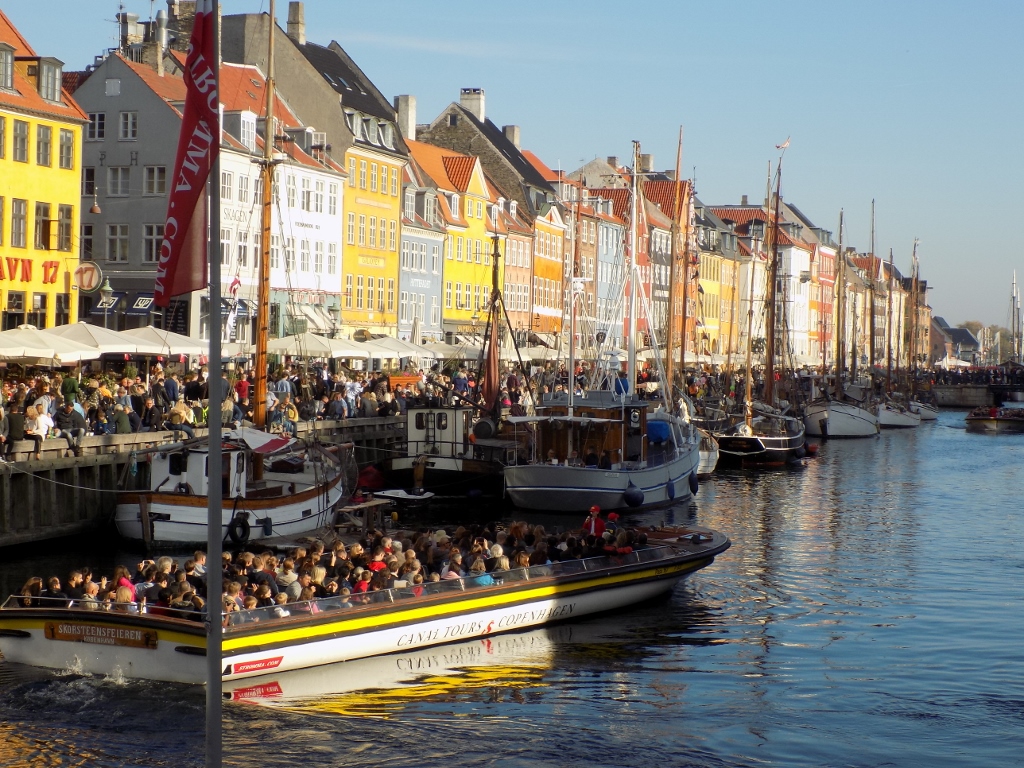 Nyhavn
Nyhavn
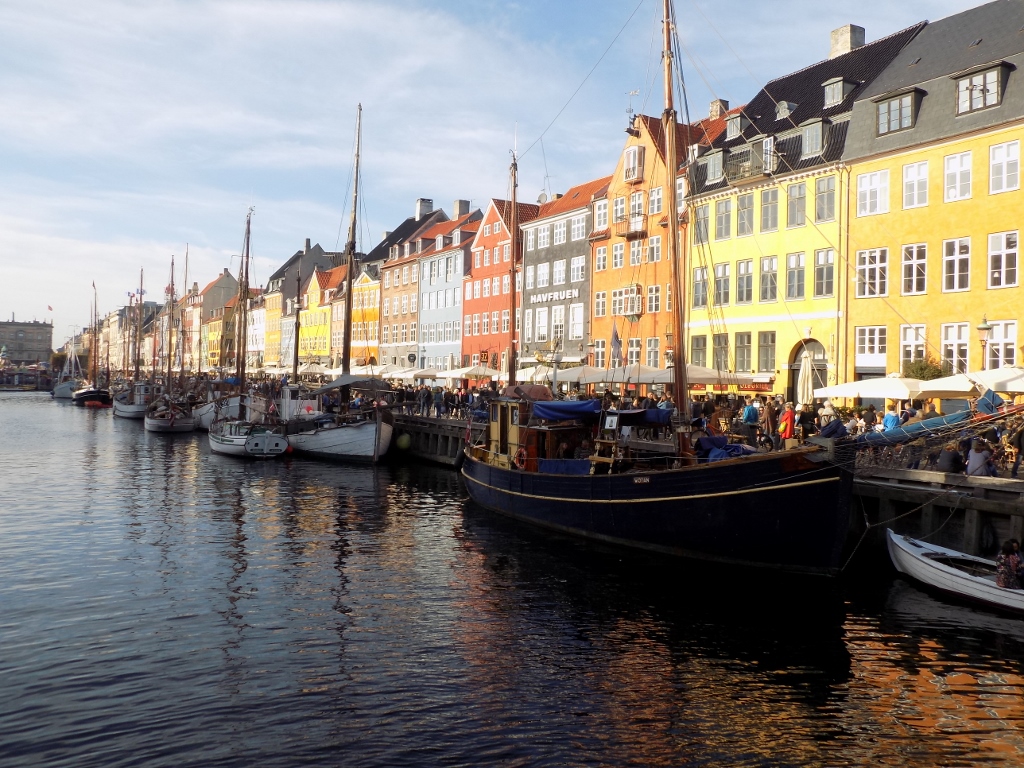 Nyhavn
Nyhavn
The New Harbour is a canal from the 17th century with picturesque houses that were built along it and nowadays there is a nice walking area, as well as numerous bars, cafés and restaurants.
Regardless of our chatting, Rade did try to draw my attention to some of the important parts we were walking by and after a nice lunch break he took me to Christiania, a very interesting project. Namely, this is a Freetown which was founded in the area of an abandoned military barracks in 1971. The closest description would be that this looks like a hippie commune, but there are permanent residents and some autonomous firm rules, while in the meantime, after numerous events, those permanent residents also became owners of the land taken by Christiania. In addition, the inhabitants of this community have also managed to negotiate with the authorities to be in a way “a country in its own right” and this is proudly displayed not only at the entrance, but primarily when leaving Christiania.
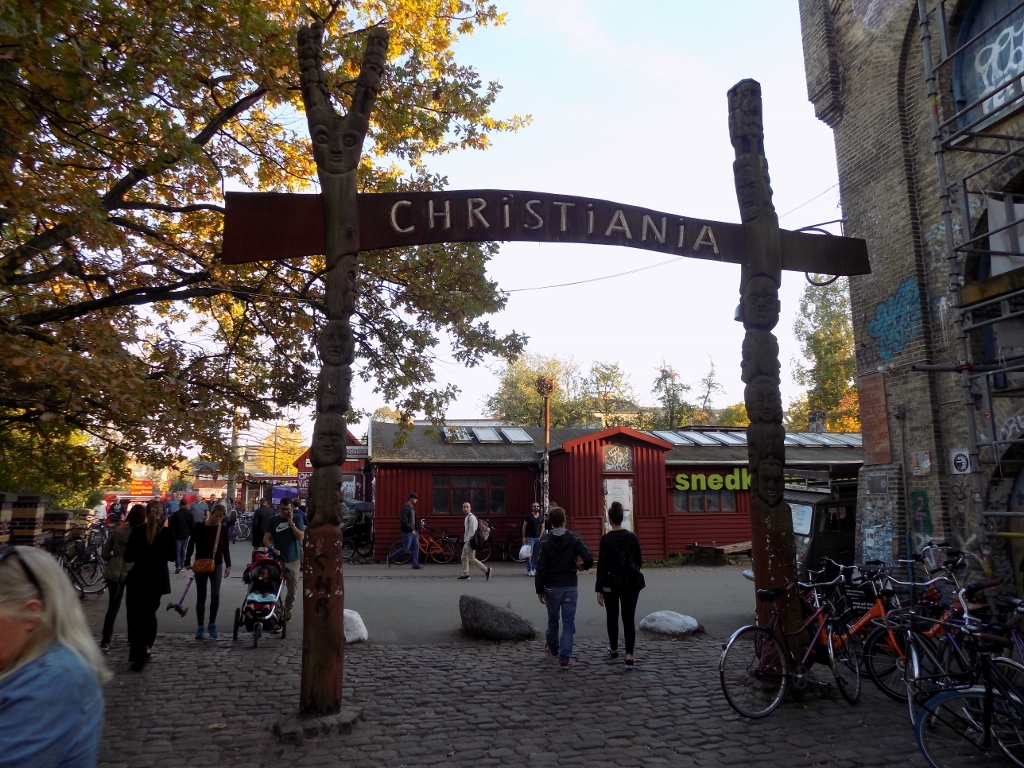 There is no border police or customs when entering Christiania...
There is no border police or customs when entering Christiania...
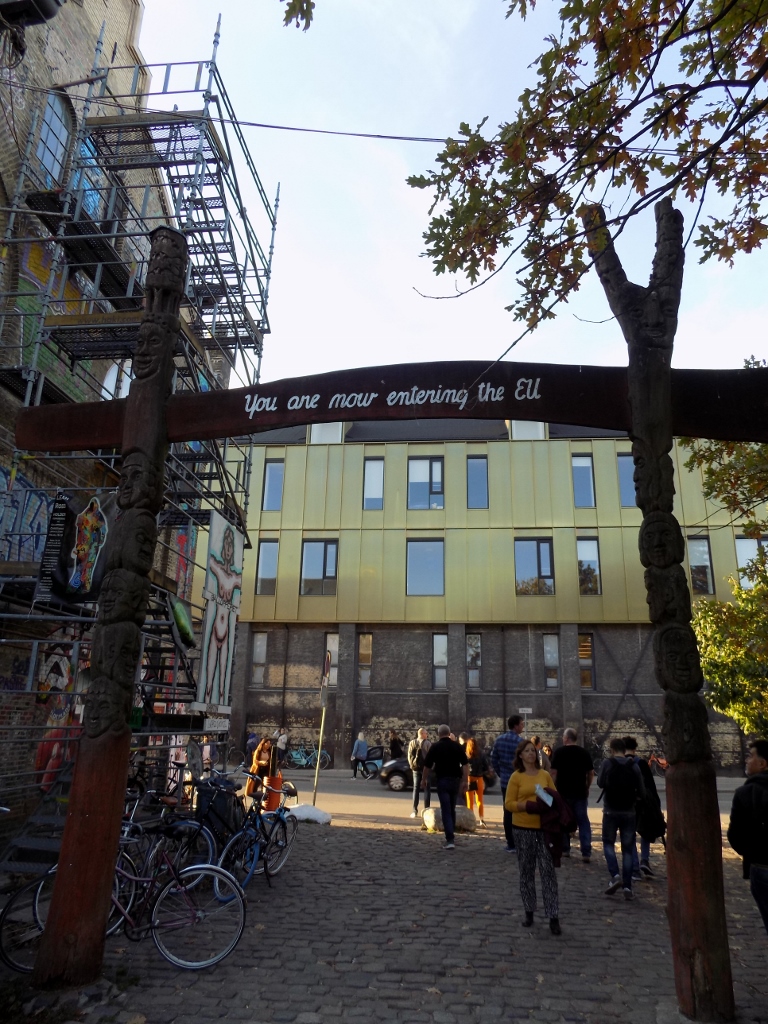 ... but when leaving there is clear information “You are now entering the EU”
... but when leaving there is clear information “You are now entering the EU”
Taking photos is not permitted in all the parts within this “state,” as far as I understood it in order not to take photos of the people selling marihuana and other “light” drugs. Namely, this is the only place in Denmark where these drugs are tolerated and this is one of the controversial things linked to Christiania. I’m generally not interested in drugs at all, but it was still remarkable to pass by small stands displaying different products, as if these were candies sold at a fair. Somebody in the know would certainly be able to discern what exactly is on sale there, but I neither know this nor do I find it important. For me, there were other nice things like picturesque small houses or a park area.
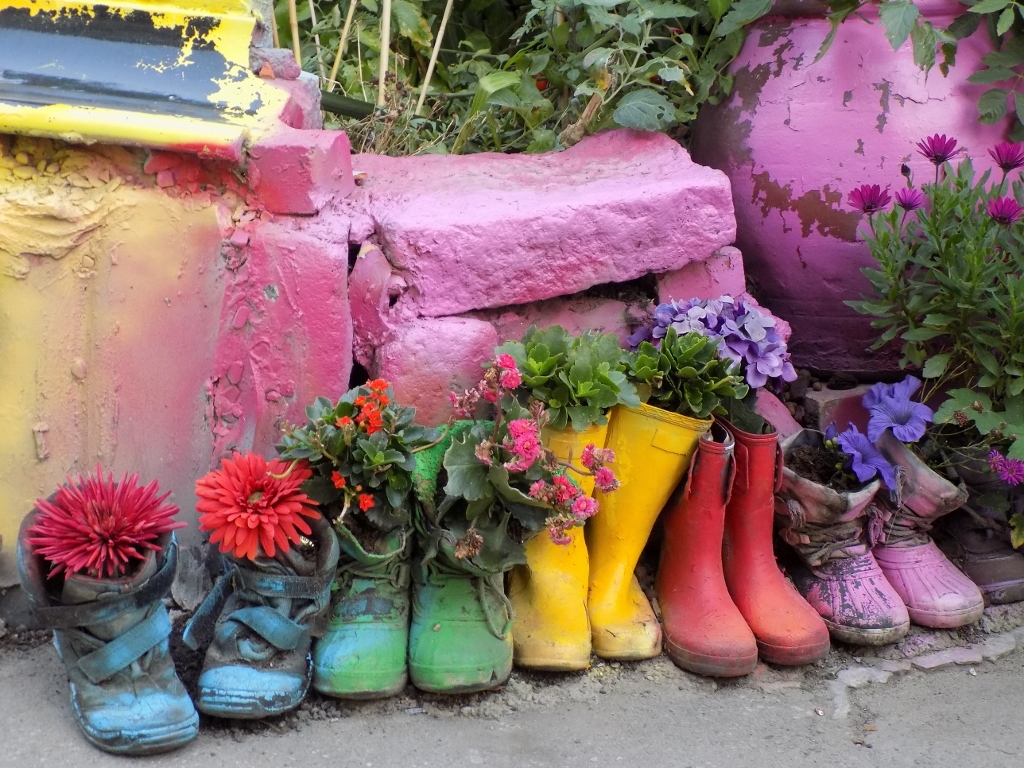 A detail from Christiania
A detail from Christiania
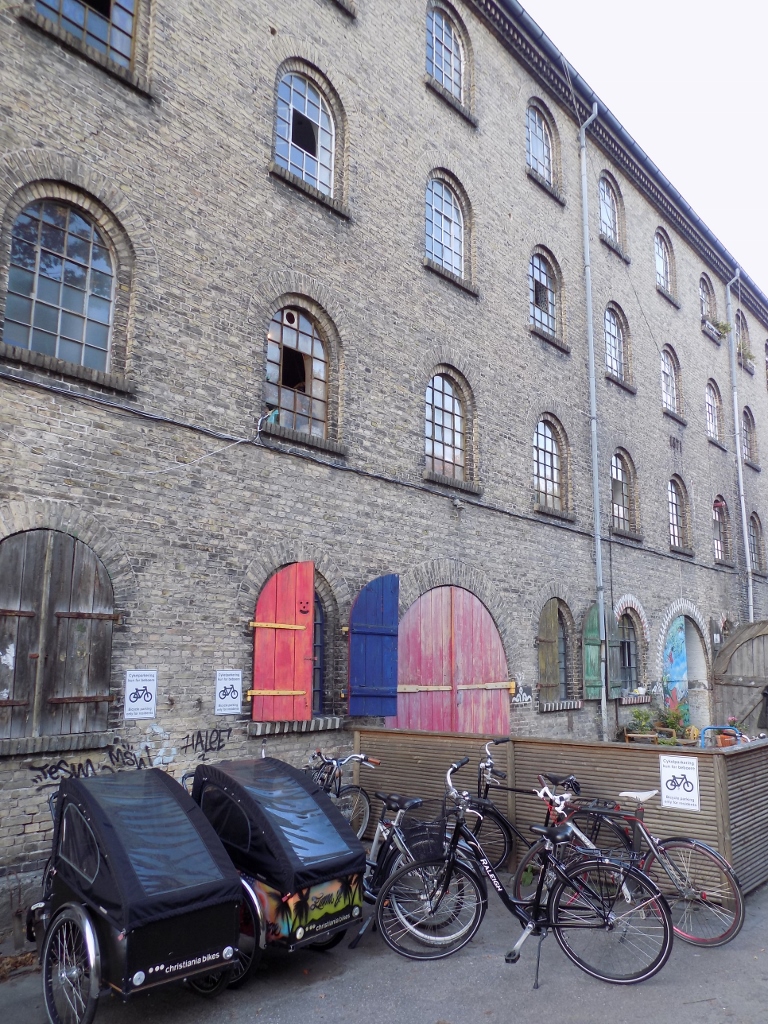 A detail from Christiania
A detail from Christiania
After this, Rade and I headed back towards the centre, but it was still nice to look back towards the part of the city we were leaving, which is called Christianshavn. It was particularly nice to look at some parts with the light of the Sun that was slowly setting.
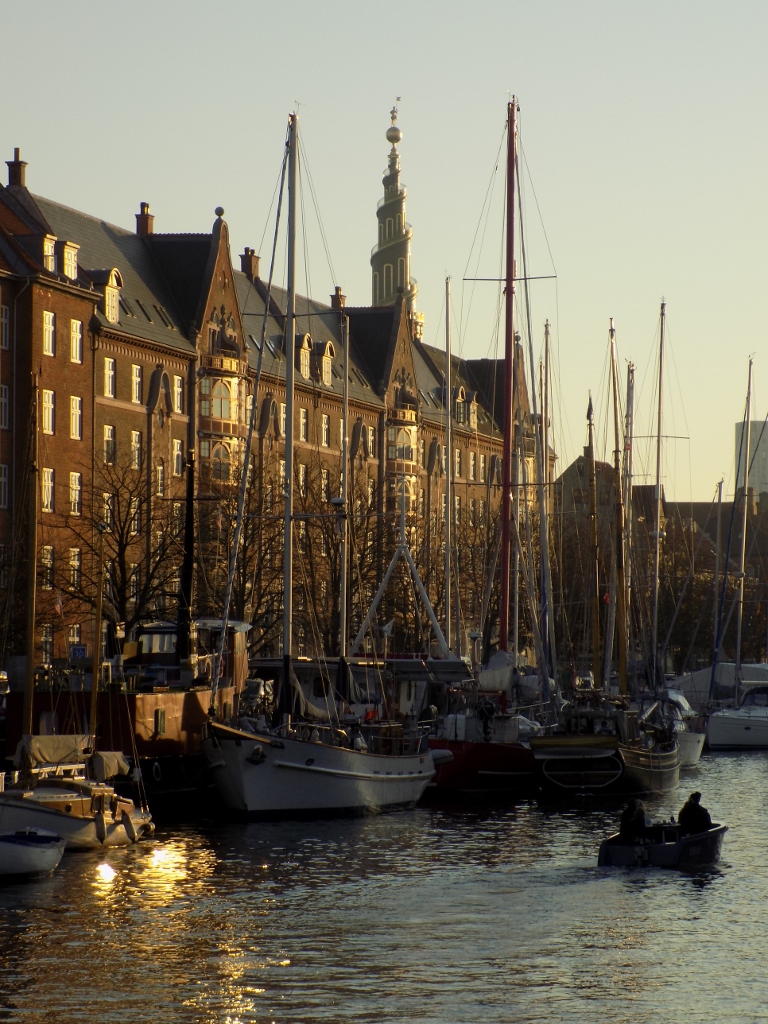 Christianshavn, including the spiral tower of the Church of Our Saviour
Christianshavn, including the spiral tower of the Church of Our Saviour
In order to return to the centre, we had to cross the pedestrian-bicycle bridge again. This is a completely new bridge that was opened less than two years ago.
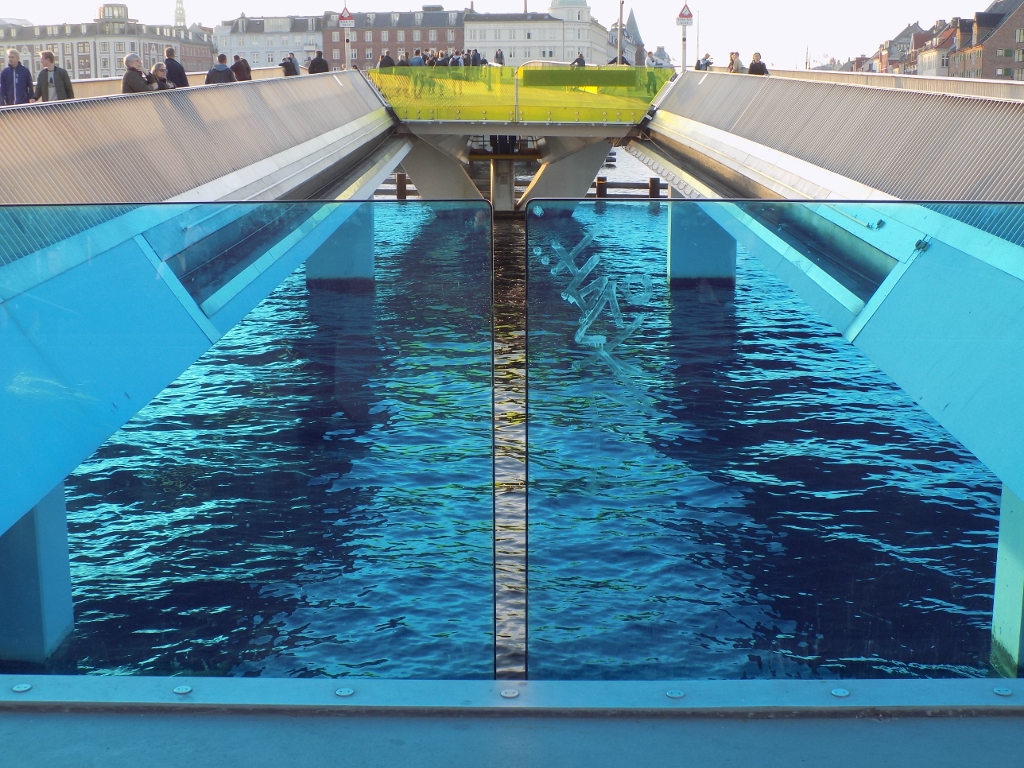 Pedestrian-bicycle bridge
Pedestrian-bicycle bridge
Since this bridge leads directly from Christianshavn to Nyhavn, it was logical to admire for a little while yet this beautiful canal and its buildings, this time with a somewhat softer light.
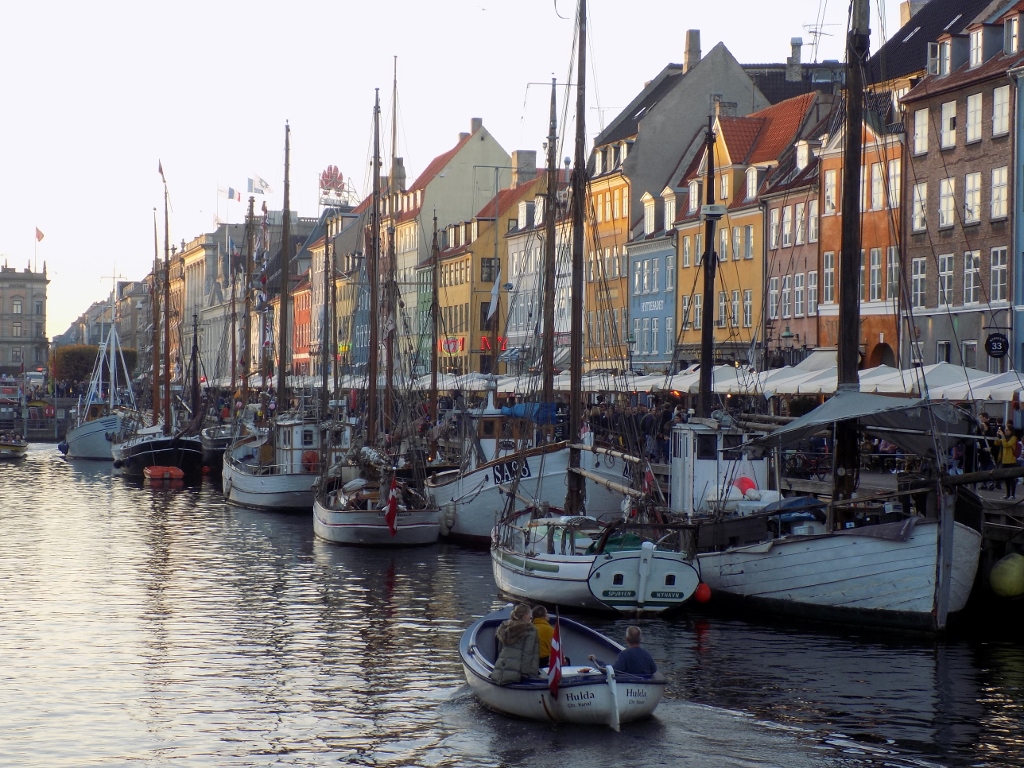 Nyhavn
Nyhavn
Then we walked to Amalienborg, the home of the Danish royal family. Amalienborg consists in fact of four identical palaces that surround an octagonal square.
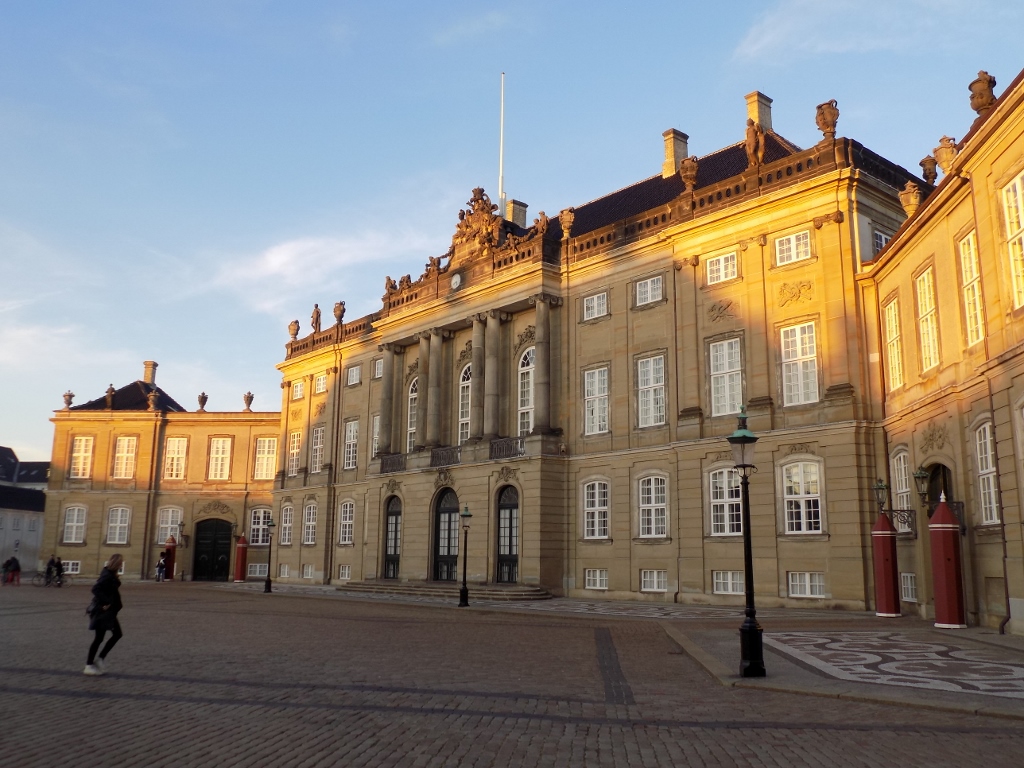 Amalienborg, Frederick VIII’s Palace
Amalienborg, Frederick VIII’s Palace
In the centre of the square, there is an equestrian monument to King Frederick V, while a little farther away there is Frederik’s Church also called the Marble Church.
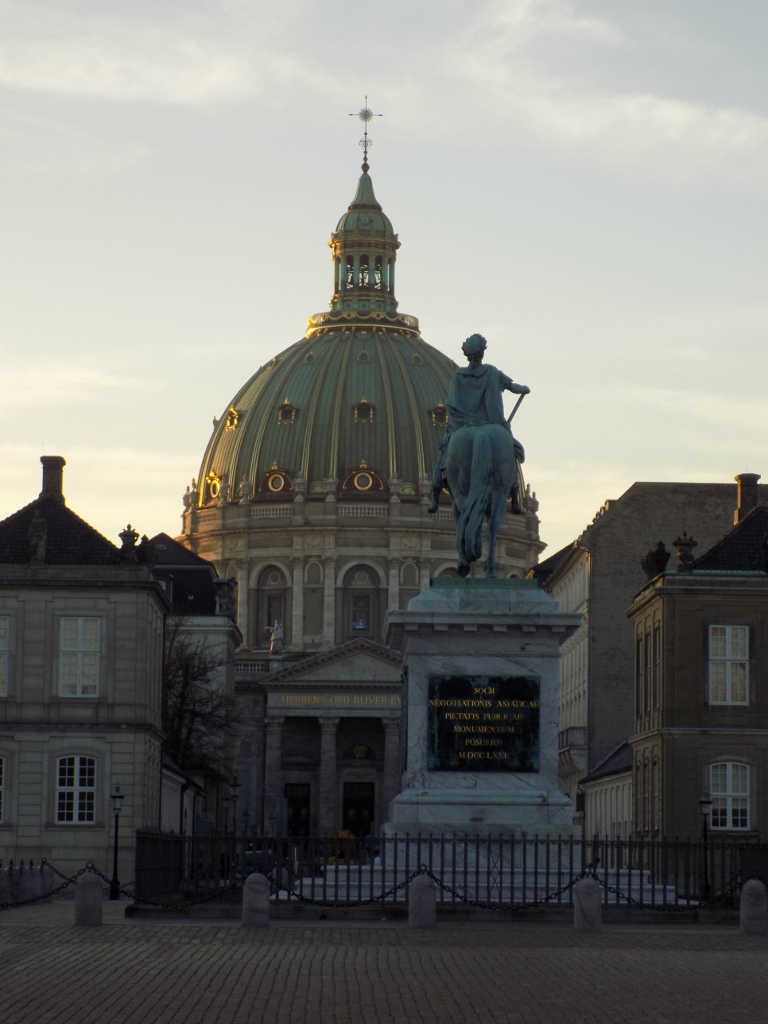 Amalienborg, monument to King Frederick V and Frederik’s Church
Amalienborg, monument to King Frederick V and Frederik’s Church
Then we went back to the shore of the strait and continued walking northwards. On the opposite side we could see very interesting and picturesque things: a contemporary power plant, Nyholm Central Guardhouse with a charming turret ending in a large crown, a “retired” war ship, as well as a masting crane from the 18th century.
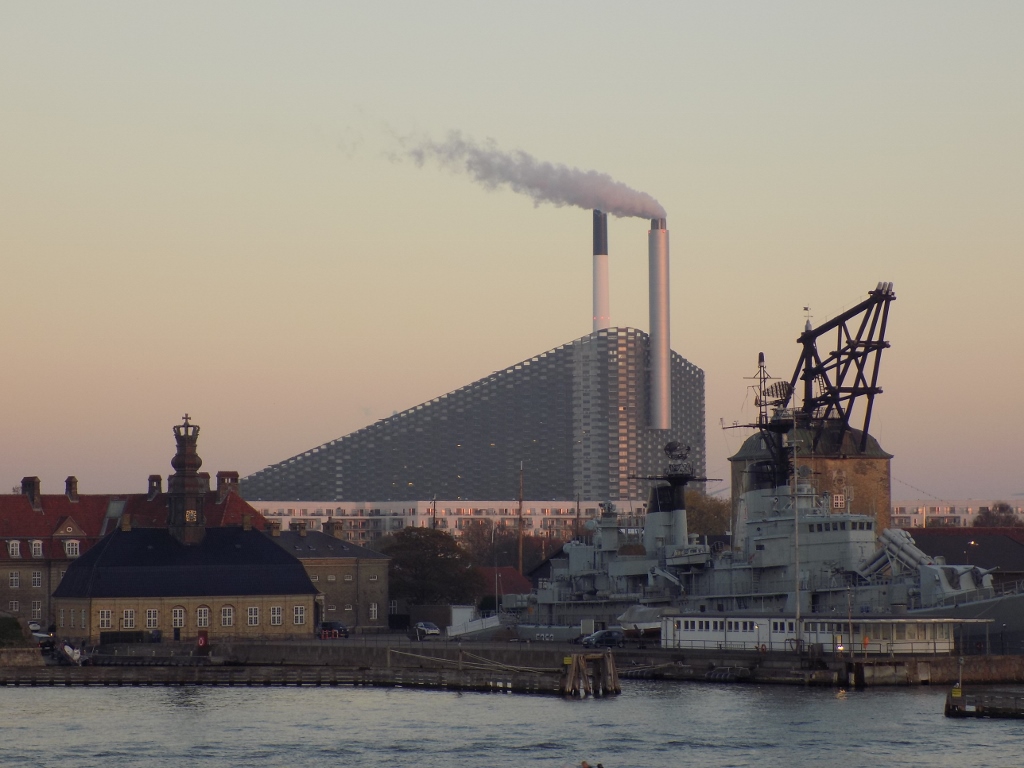 A guardhouse with a crown on top, a modern power plant, a “retired” war ship and the top of a masting crane
A guardhouse with a crown on top, a modern power plant, a “retired” war ship and the top of a masting crane
Soon we also passed by Kastellet, one of the best preserved fortresses in north Europe, but it was already sufficiently late that we only enjoyed the pretty reflection of the sky in the dusk which was mirrored in the waters filling out the moat.
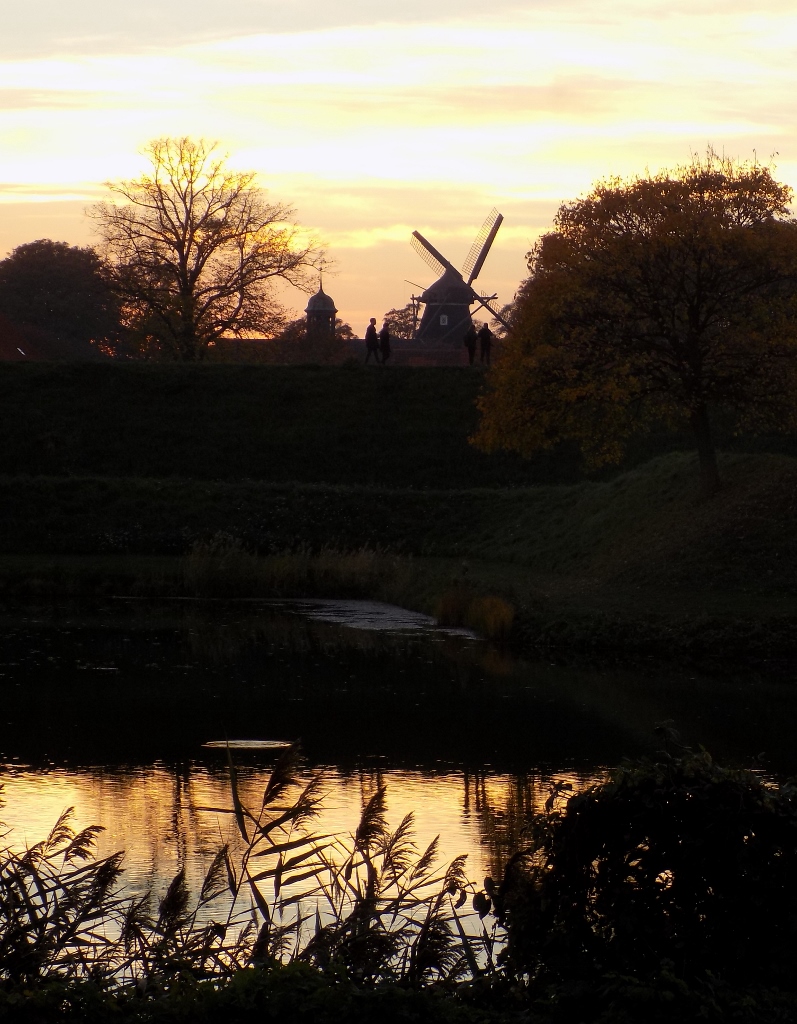 A detail of Kastellet
A detail of Kastellet
And finally, as the goal of our late walk, we came to the unavoidable Little Mermaid, one of the symbols of Copenhagen. This statue made of bronze is based on a fairy-tale written precisely by a Danish author, Hans Christian Andersen. It was placed here in 1913 and it may be seen sitting on a rock right next to the walking area.
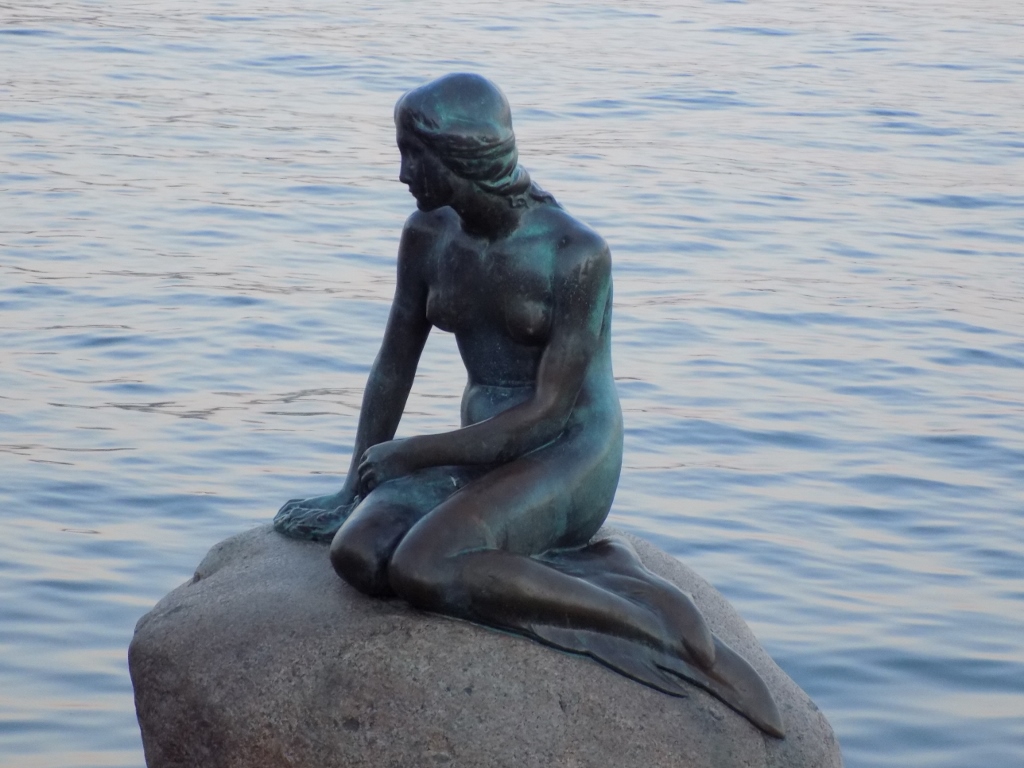 The Little Mermaid
The Little Mermaid
It was now getting really dark, so we returned to the centre and there we went for wonderful cakes and drinks since Rade had had his birthday the week before, so in this way we had a somewhat late, but still good celebration of his special day.
The following day we went together to the town of Roskilde. This was the first capital of united Denmark and Norway chosen by Harald Bluetooth who was, by the way, one of the rulers we have to thank for the two large stones with runes that are located in Jelling village which I visited later on. Since Harald Bluetooth is also important on account of converting to Christianity, “his” new capital soon got its first bishop (in 1020). Those bishops of Roskilde were incredibly influential over the next 300 years, especially Bishop Absalon who is considered the official founder of Copenhagen.
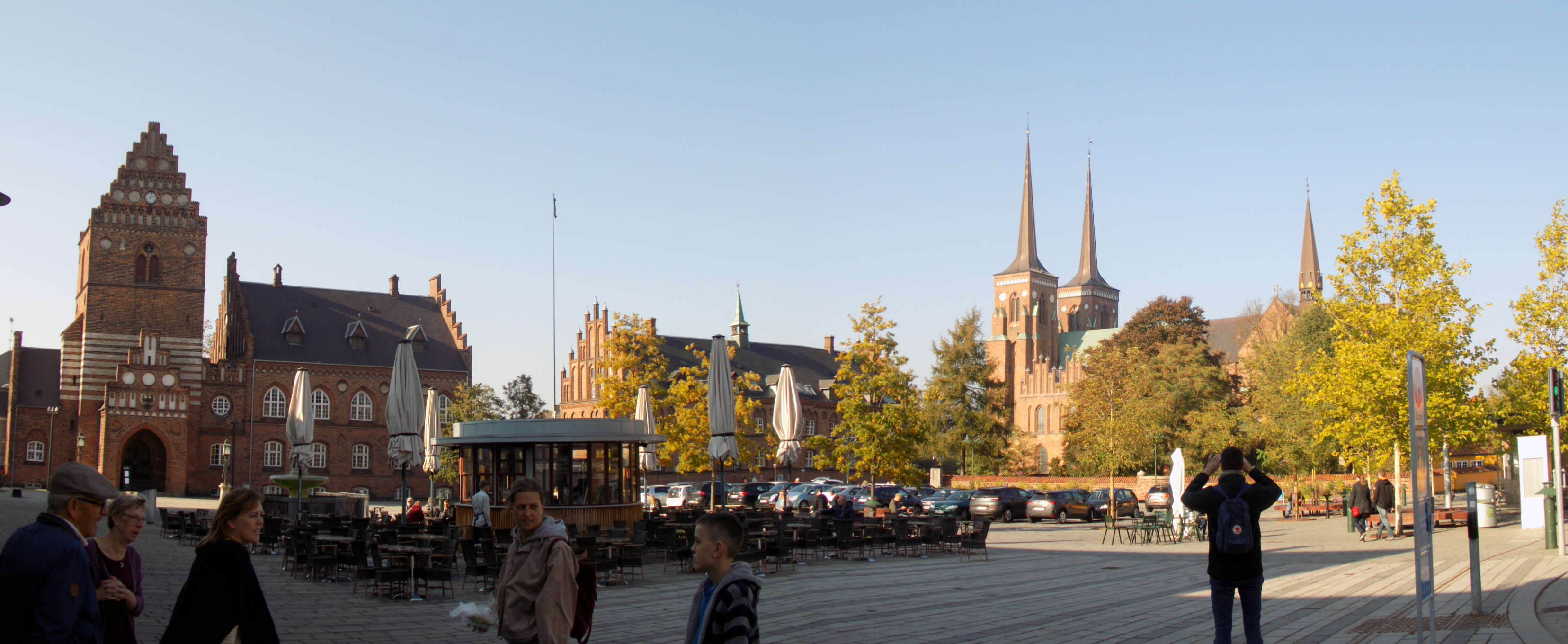
In 1417, Erik of Pomerania moved the capital to Copenhagen, but the importance of Roskilde did not diminish with that. Namely, in 1170, Bishop Absalon started the construction of the Cathedral (it was finished in the 13th century) and in 1413, a year after her death, the remains of Queen Margaret I were transferred and buried here. Thus the tradition of burying Danish rulers in this Cathedral started and to date 38 kings and queens have been buried here. In addition, there are also graves of other members of the royal families, as well as those of some wealthy and influential individuals.
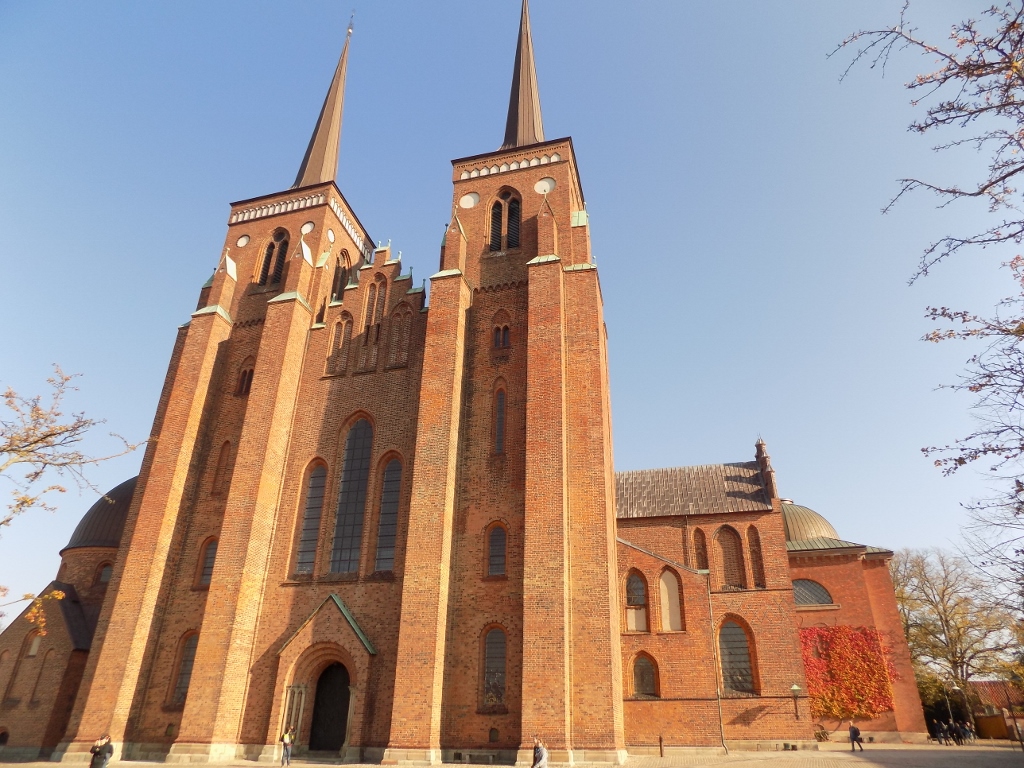 Cathedral in Roskilde
Cathedral in Roskilde
To start with we went around in order to see the Cathedral from the outside. In the back section, there is a covered bridge that joins the Cathedral and a bishop’s residence, and it is called the Absalon Arch. Although it was Sunday and the day was gorgeous, I found it interesting that we actually met very few people.
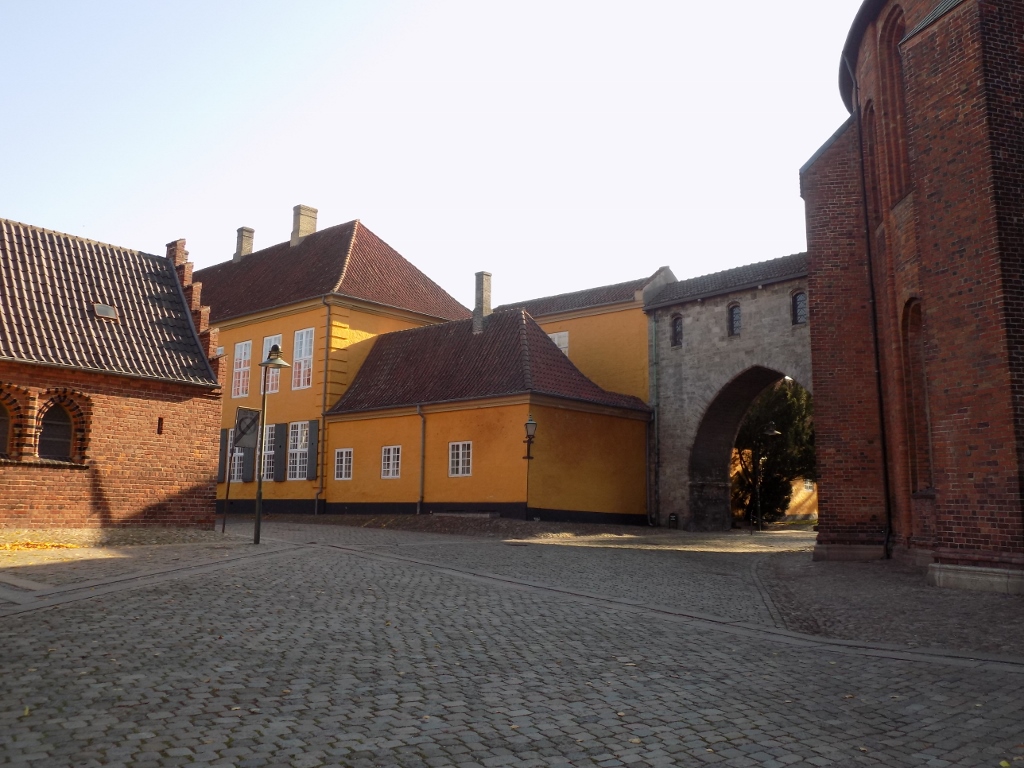 Absalon Arch
Absalon Arch
When we finished the whole circle around the Cathedral, Rade and I finally went in. The Cathedral in Roskilde is included in the UNESCO’s World Heritage List and on this occasion Rade and I visited it nicely and thoroughly.
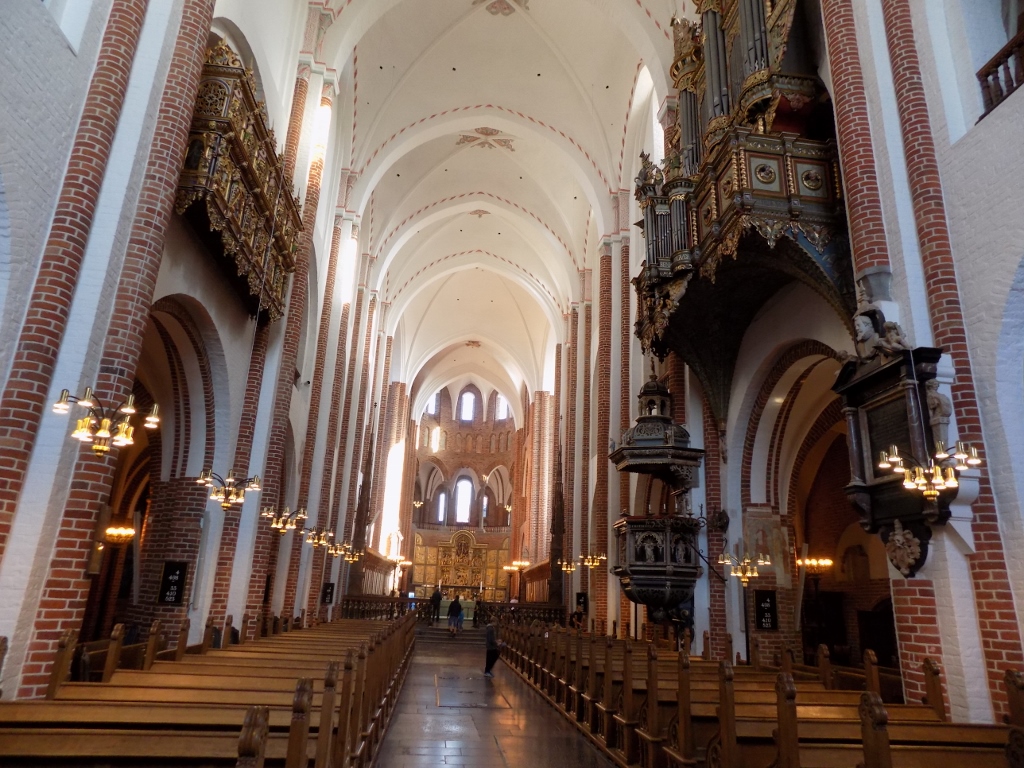 Interior of the Cathedral in Roskilde
Interior of the Cathedral in Roskilde
This is the first Gothic cathedral in Scandinavia that was made of bricks and later this style spread throughout north Europe. As I’ve said, the Danish rulers have started to be buried here already since the 15th century, but since there was not enough space for all of them over the centuries, different chapels have been added laterally and it is therefore possible to see examples of different architectural styles that reflect the times in which the chapels were built.
In a spacious sepulchral chapel on the left-hand side, there are several sarcophaguses. I don’t want to go into a detailed story about the Danish rulers buried in different chapels, but I found a practically trivial piece of data particularly interesting. It concerns the sculptures by the sarcophagus of Christian IX and his wife Louise. Namely, these three sculptures of women symbolise Remembrance, Love and Grief, and their author is Edvard Eriksen, the same one who did the Little Mermaid that is located in Copenhagen. The trivial piece of data I’m talking about is that the sculptor used his wife as the model of all three sculptures here, as well as for the Little Mermaid, and for these reason these three female figures are called the Little Mermaid’s sisters.
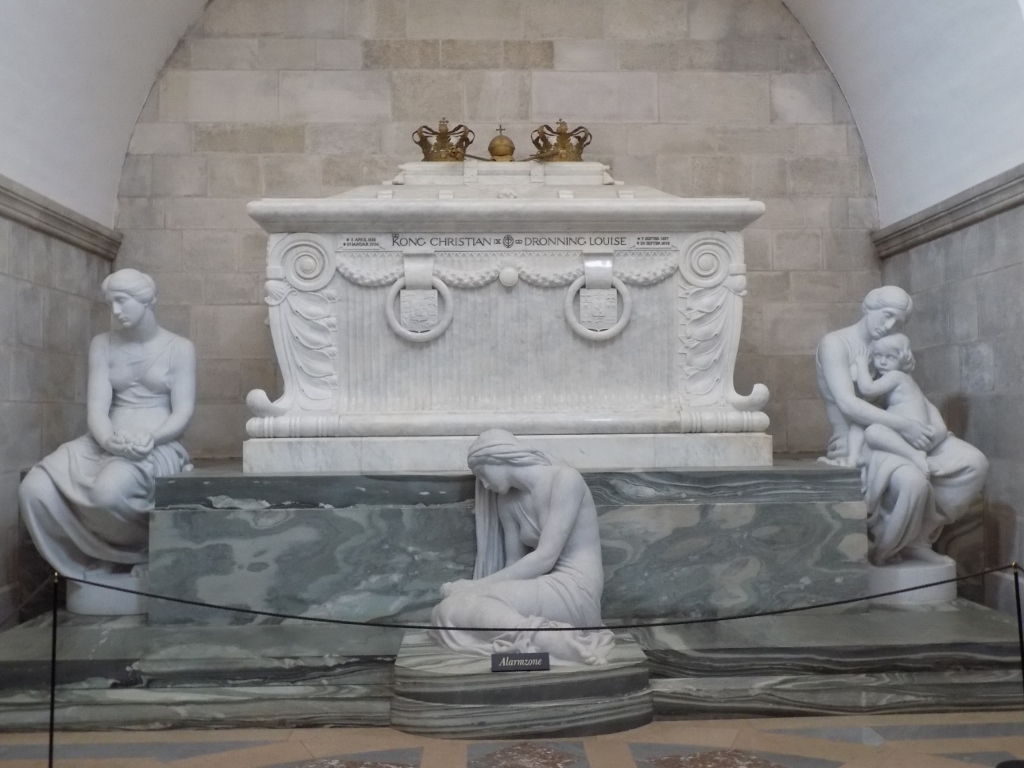 The Little Mermaid’s sisters
The Little Mermaid’s sisters
The next one, Saint Birgitta’s Chapel, is interesting because it has been foreseen that this will be the place of burial of the currently ruling Danish royal couple, Queen Margrethe II and her husband. Although it is already known what her sarcophagus is going to look like and who its author is, in the chapel richly decorated with the 16th-century frescoes there is only a simple stylised installation.
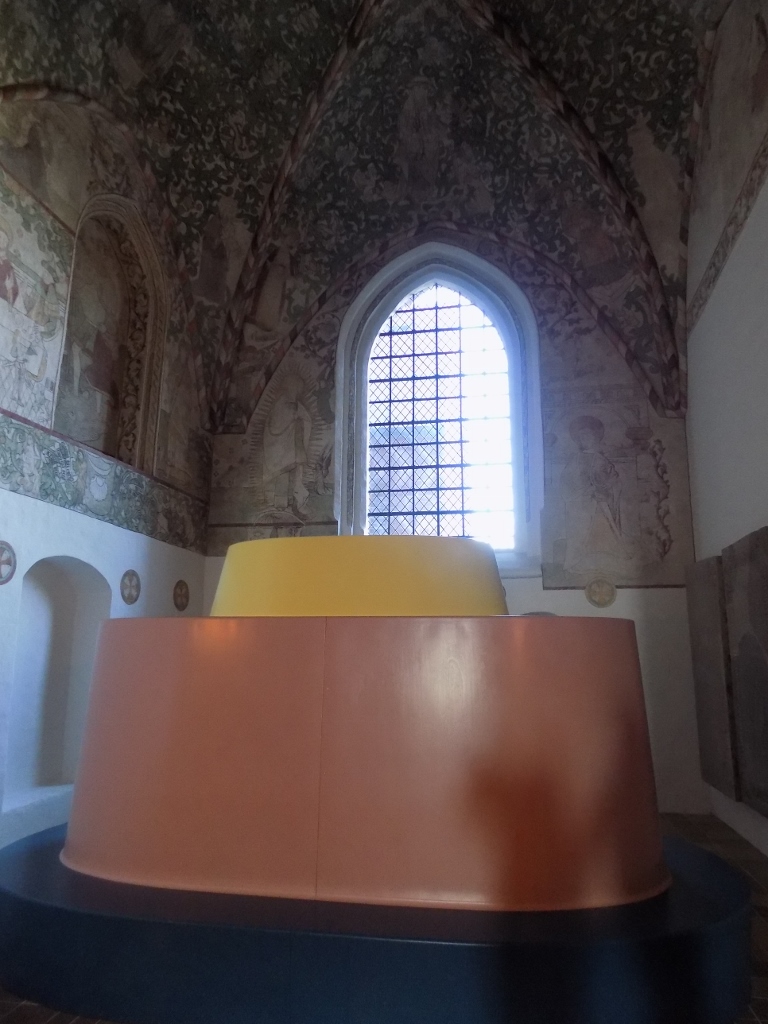 Saint Birgitta’s Chapel
Saint Birgitta’s Chapel
And so, chapel by chapel, we visited the entire Cathedral. There were still interesting parts and details, but we also wanted to get to another important place in the town of Roskilde.
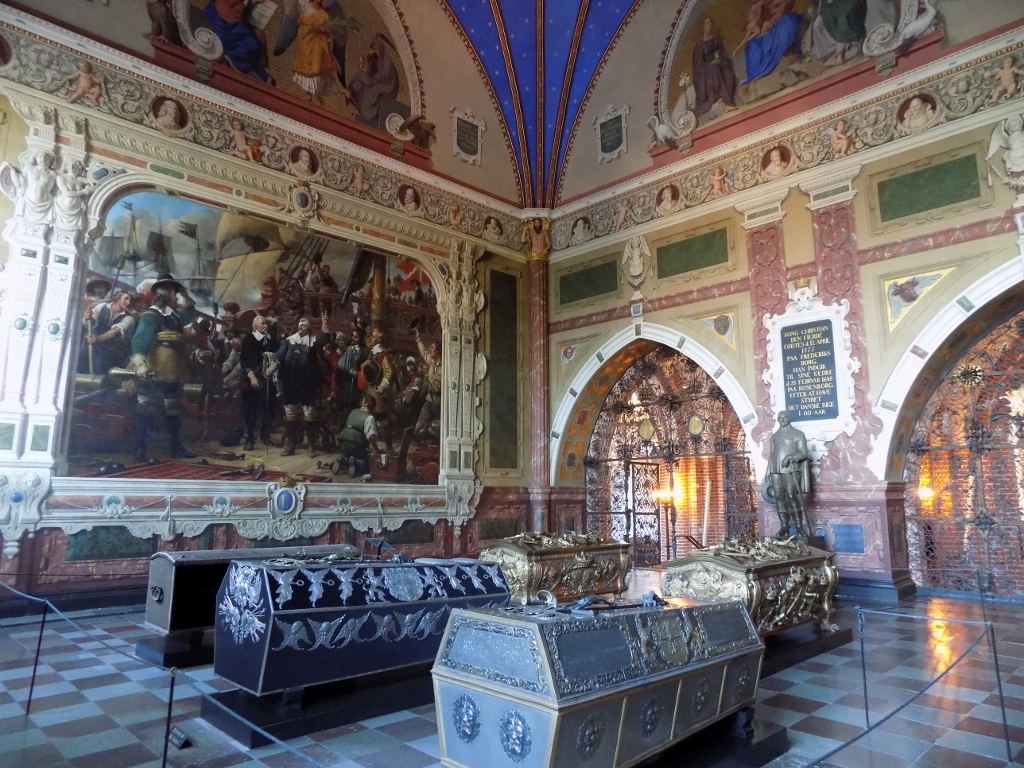 Christian IV’s Chapel
Christian IV’s Chapel
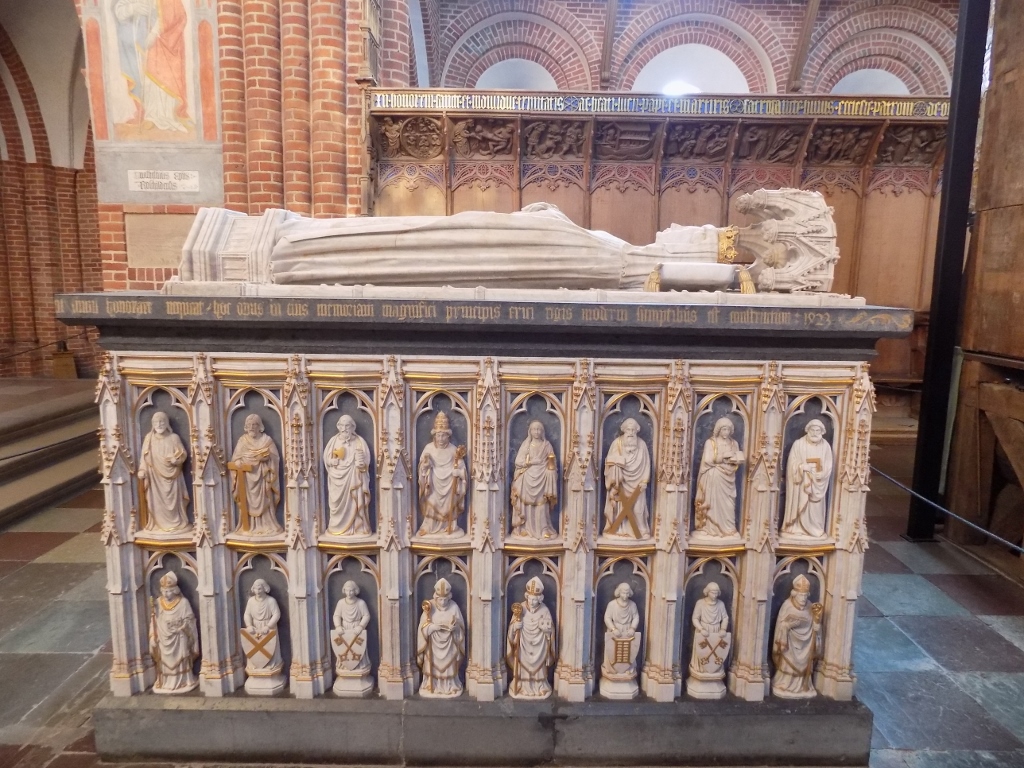 Queen Margaret I’s sarcophagus
Queen Margaret I’s sarcophagus
Namely, after our visit to the Cathedral, we went down to the nearby Roskilde Fjord. This is one of the two biggest fjords in Denmark and they are both located in the north of the island of Zealand (the other one is Ise Fjord). Still, the main reason for going to the shores of the fjord was to visit the Viking Ship Museum. Although this is a small and, if I can put it that way, modest museum, this is certainly a place that should not be skipped when visiting Roskilde, because it houses a stunning discovery. Namely, in order to get from Roskilde to the open sea by boat, it is necessary to sail along the 30-km long fjord. In one section, there are three branches that may be followed. But, in the same way in which boats go to the open sea, it is possible for the conquerors to get here, as they used to do in the past. In order to protect their capital, the Vikings sank 5 vessels in the branch of the fjord that was the most direct route in order to prevent or at least made the access for the enemy’s ships more difficult. They also had other systems they applied in the remaining two branches and most probably they themselves primarily used the longest and the most meandering branch. Be as it may, the time passed in the form of centuries and occasionally the fjord waters brought to the shore parts of these sunken ships. Thus, in the second half of the 20th century, an archaeologist started to explore it in more detail and eventually found the remains of these vessels. Then an exploration team surrounded the site separating it from the rest of the fjord, and then they pumped out the water and came to the silt bottom. There they extracted everything manually lest the delicate remains got destroyed and then everything was rinsed and specially treated. Finally, through very slow and meticulous work the scientists managed to assemble the ships and all of this took around 20 years. Nowadays these ships, i.e., their remains may be seen at the museum built especially for them. These are 5 boats and they are all different having been used for different purposes.
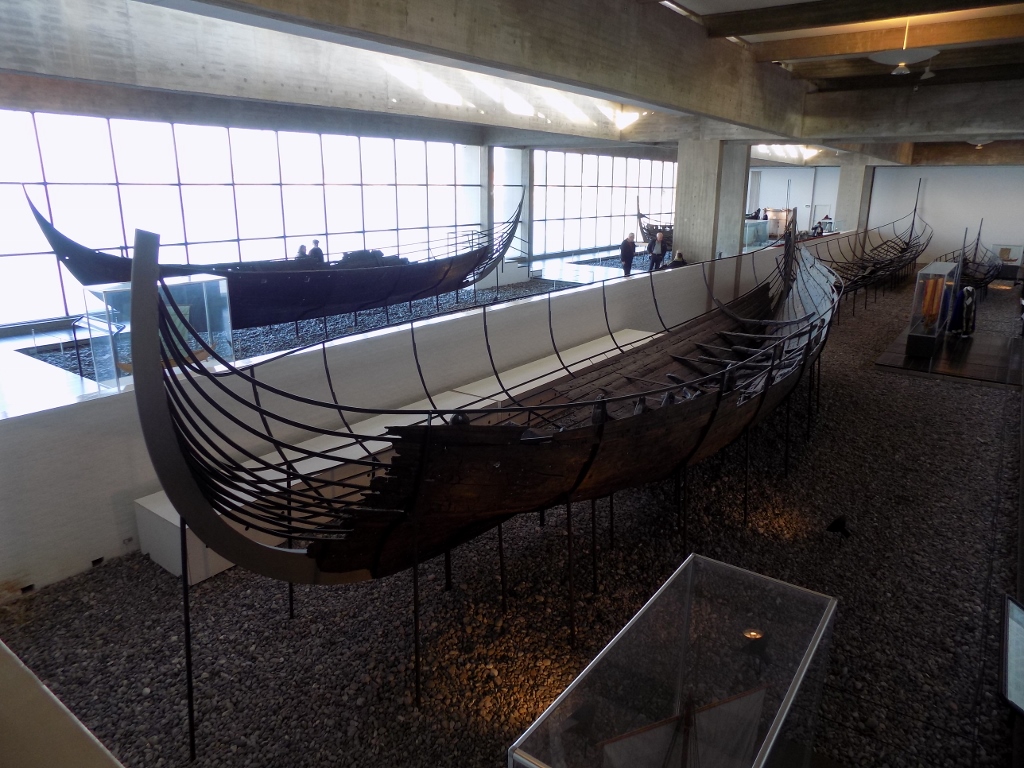 The Viking Ship Museum’s exhibits
The Viking Ship Museum’s exhibits
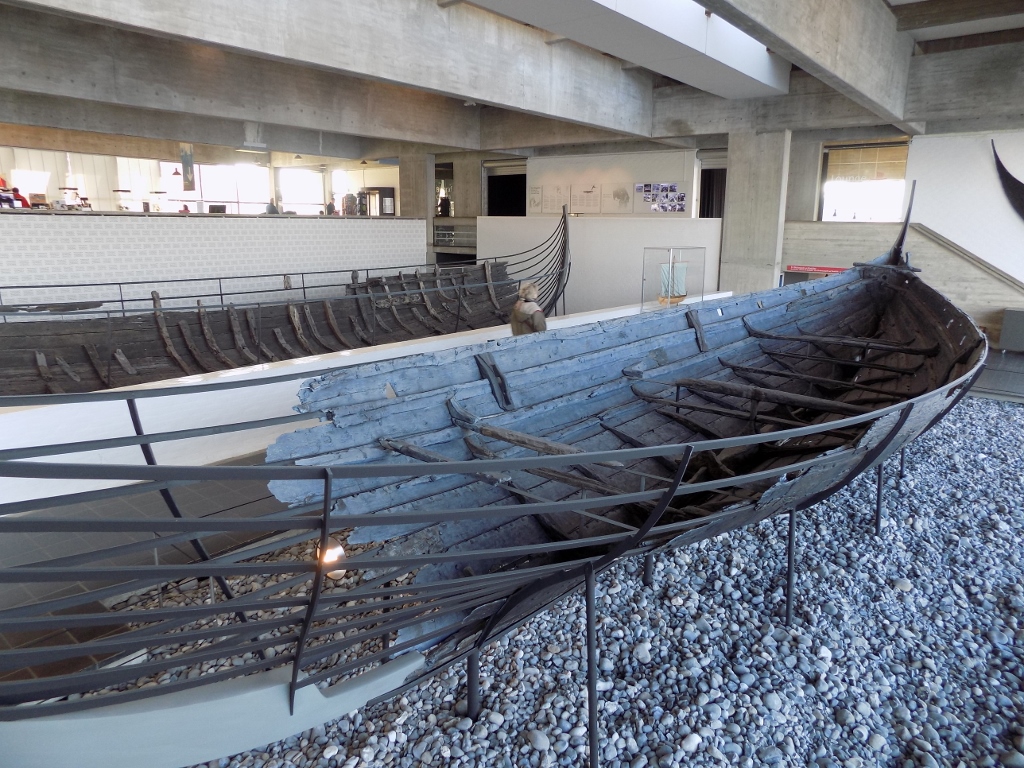 The Viking Ship Museum’s exhibits
The Viking Ship Museum’s exhibits
This enclosed part of the museum is not particularly big and can be visited rather quickly, but there is also another part that may be visited outside. To start with, close to the fjord’s shore, we came across a small meditative labyrinth – a labyrinth made almost at the level of the ground. Both Rade and I tried it, but without too much meditation.
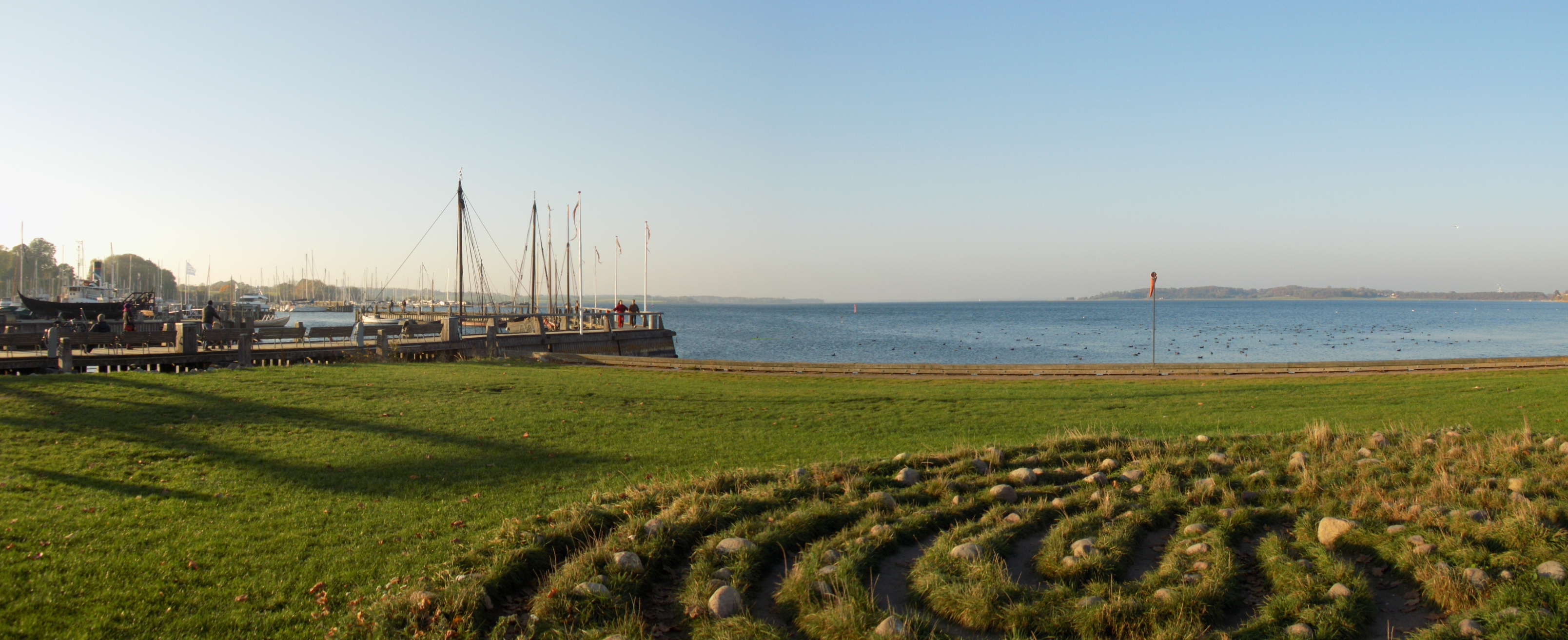
So, the museum also includes different workshops where visitors may join the making of ships in the traditional, Viking way. Of course, we did not try it ourselves, but it was still impressive to see different tools and I must admit that I’m always amazed by how the ancient people, without the modern aids we have nowadays, managed to come up with and develop different ways for making ships (or all sorts of other things) until they got to best version.
It was also fantastic to see in a workshop a real boat in the making and it all appeared so delicate and meticulous, as if they were making but a small jewellery box or a piece of furniture and not an impressive vessel.
Also, since the discovery, contemporary replicas of those ships taken out from the silt that are now in the museum have been made and they are used for tourist outings around the fjord. Unfortunately, the two of us did not have the time, but it was still nice seeing them docked by the pier.
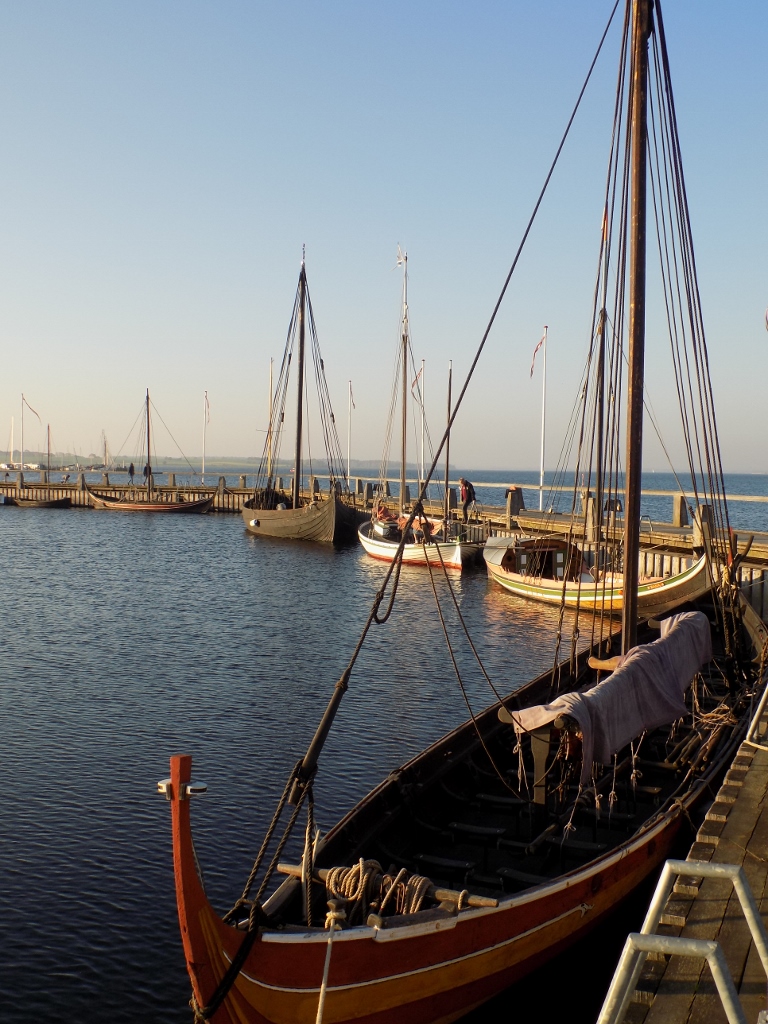 Viking ships from the 21st century
Viking ships from the 21st century
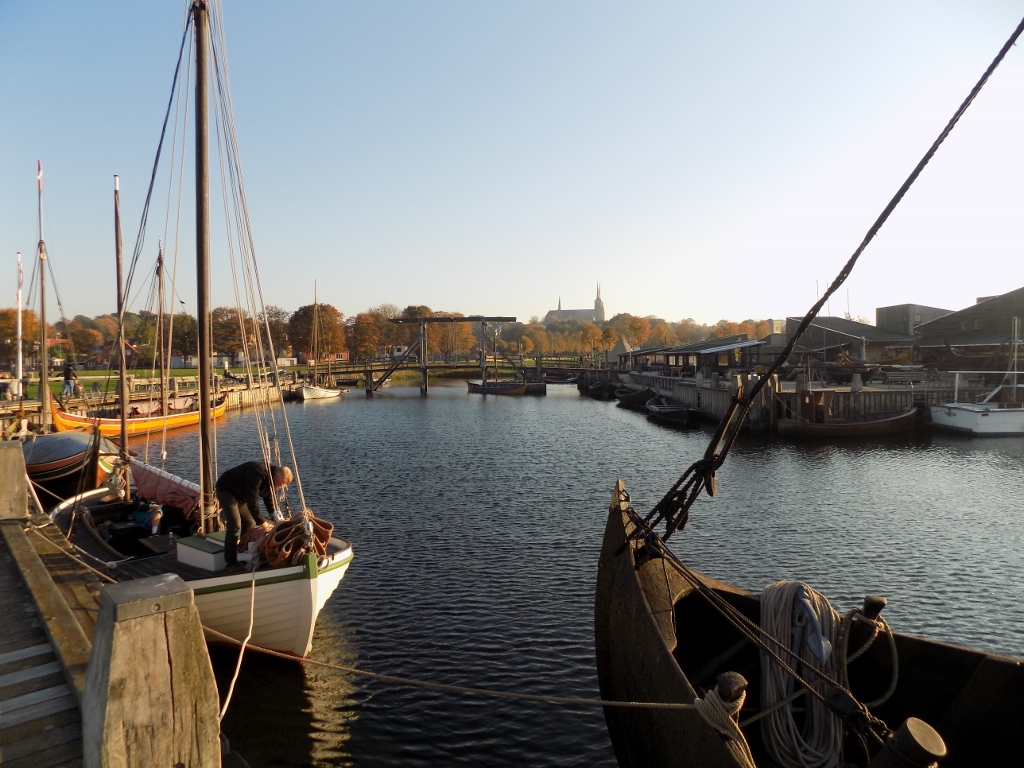 Viking ships in the port on the left-hand side, with the Cathedral in the distance
Viking ships in the port on the left-hand side, with the Cathedral in the distance
Upon our return to Copenhagen we went for a nice dinner and soon we returned to the flat in order to get some rest and get ready for the following day, each of us according to his/her own plan. Rade was going to work and I was going to continue with my visit to Denmark.